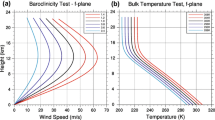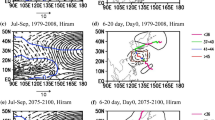Abstract
The sensitivity of idealised baroclinic waves to different atmospheric temperature changes is studied. The temperature changes are based on those which are expected to occur in the Northern Hemisphere with climate change: (1) uniform temperature increase, (2) decrease of the lower level meridional temperature gradient, and (3) increase of the upper level temperature gradient. Three sets of experiments are performed, first without atmospheric moisture, thus seeking to identify the underlying adiabatic mechanisms which drive the response of extra-tropical storms to changes in the environmental temperature. Then, similar experiments are performed in a more realistic, moist environment, using fixed initial relative humidity distribution. Warming the atmosphere uniformly tends to decrease the kinetic energy of the cyclone, which is linked both to a weaker capability of the storm to exploit the available potential energy of the zonal mean flow, and less efficient production of eddy kinetic energy in the wave. Unsurprisingly, the decrease of the lower level temperature gradient weakens the resulting cyclone regardless of the presence of moisture. The increase of the temperature gradient in the upper troposphere has a more complicated influence on the storm dynamics: in the dry atmosphere the maximum eddy kinetic energy decreases, whereas in the moist case it increases. Our analysis suggests that the slightly unexpected decrease of eddy kinetic energy in the dry case with an increased upper tropospheric temperature gradient originates from the weakening of the meridional heat flux by the eddy. However, in the more realistic moist case, the diabatic heating enhances the interaction between upper- and low-level potential vorticity anomalies and hence helps the surface cyclone to exploit the increased upper level baroclinicity.











Similar content being viewed by others
References
Bengtsson L, Hodges KI, Roeckner E (2006) Storm tracks and climate change. J Clim 19:3518–3543
Bengtsson L, Hodges KI, Keenlyside N (2009) Will extratropical storms intensify in a warmer climate? J Clim 22:2276–2301
Blázquez J, Pessacg NL, Gonzalez PL (2013) Simulation of a baroclinic wave with the wrf regional model: sensitivity to the initial conditions in an ideal and a real experiment. Meteorol Appl 20:447–456
Boer G, Lambert S (2008) The energy cycle in atmospheric models. Clim Dyn 30:371–390
Booth JF, Wang S, Polvani L (2013) Midlatitude storms in a moister world: lessons from idealized baroclinic life cycle experiments. Clim Dyn 41:787–802
Boutle I, Beare R, Belcher SE, Brown A, Plant RS (2010) The moist boundary layer under a mid-latitude weather system. Bound-Lay Meteorol 134:367–386
Boutle I, Belcher S, Plant R (2011) Moisture transport in midlatitude cyclones. Q J R Meteor Soc 137:360–373
Catto JL, Shaffrey LC, Hodges KI (2011) Northern Hemisphere extratropical cyclones in a warming climate in the HiGEM high-resolution climate model. J Clim 24:5336–5352
Dudhia J (1989) Numerical study of convection observed during the winter monsoon experiment using a mesoscale two-dimensional model. J Atmos Sci 46:3077–3107
Fantini M (2004) Baroclinic instability of a zero-PVE jet: Enhanced effects of moisture on the life cycle of midlatitude cyclones. J Atmos Sci 61:1296–1307
Fink AH, Brücher T, Ermert V, Krüger A, Pinto JG (2009) The European storm Kyrill in January 2007: synoptic evolution, meteorological impacts and some considerations with respect to climate change. Nat Hazard Earth Sys 9:405–423
Hong SY, Dudhia J, Chen SH (2004) A revised approach to ice microphysical processes for the bulk parameterization of clouds and precipitation. Mon Weather Rev 132:103–120
Hong SY, Noh Y, Dudhia J (2006) A new vertical diffusion package with an explicit treatment of entrainment processes. Mon Weather Rev 134:2318–2341
Hoskins BJ, McIntyre M, Robertson AW (1985) On the use and significance of isentropic potential vorticity maps. Q J R Meteor Soc 111:877–946
Kain JS, Fritsch JM (1993) Convective parameterization for mesoscale models: the Kain–Fritsch scheme. In: The representation of cumulus convection in numerical models, Springer, pp 165–170
Kirshbaum DJ, Merlis T, Gyakum J, McTaggart-Cowan R (2018) Sensitivity of idealized moist baroclinic waves to environmental temperature and moisture content. J Atmos Sci 75:337–360
Lambert SJ, Fyfe JC (2006) Changes in winter cyclone frequencies and strengths simulated in enhanced greenhouse warming experiments: results from the models participating in the IPCC diagnostic exercise. Clim Dyn 26:713–728
Lorenz EN (1955) Available potential energy and the maintenance of the general circulation. Tellus 7:157–167
O’Gorman PA (2011) The effective static stability experienced by eddies in a moist atmosphere. J Atmos Sci 68:75–90
Oort AH (1964) On estimates of the atmospheric energy cycle. Mon Weather Rev 92:483–493
Paulson CA (1970) The mathematical representation of wind speed and temperature profiles in the unstable atmospheric surface layer. J Appl Meteorol 9:857–861
Pfahl S, Ogorman PA, Singh MS (2015) Extratropical cyclones in idealized simulations of changed climates. J Clim 28:9373–9392
Rantanen M, Räisänen J, Lento J, Stepanyuk O, Räty O, Sinclair VA, Järvinen H (2017) OZO v. 1.0: software for solving a generalised omega equation and the Zwack-Okossi height tendency equation using WRF model output. Geosci Model Dev 10:827–841
Shamarock W, Klemp J, Dudhia J, Gill D, Barker D, Duda M, Huang X, Wang W, Powers J (2008) A description of the advanced research WRF version 3. NCAR technical note NCAR/TN/u2013475
Sinclair VA, Keyser D (2015) Force balances and dynamical regimes of numerically simulated cold fronts within the boundary layer. Q J R Meteor Soc 141:2148–2164
Sinclair VA, Belcher SE, Gray SL (2010) Synoptic controls on boundary-layer characteristics. Bound-Lay Meteorol 134:387–409
Solomon S (2007) Climate change 2007 - the physical science basis: Working group I contribution to the fourth assessment report of the IPCC, vol 4. Cambridge University Press, Cambridge
Stansifer EM, O’Gorman PA, Holt JI (2017) Accurate computation of moist available potential energy with the Munkres algorithm. Q J R Meteor Soc 143:288–292
Tierney G, Posselt DJ, Booth JF (2018) An examination of extratropical cyclone response to changes in baroclinicity and temperature in an idealized environment. Clim Dyn 1–18
Waite ML, Snyder C (2009) The mesoscale kinetic energy spectrum of a baroclinic life cycle. J Atmos Sci 66:883–901
Wernli H, Dirren S, Liniger MA, Zillig M (2002) Dynamical aspects of the life cycle of the winter storm Lothar (24–26 December 1999). Q J R Meteor Soc 128:405–429
Whitaker JS, Davis CA (1994) Cyclogenesis in a saturated environment. J Atmos Sci 51:889–908
Woollings T (2008) Vertical structure of anthropogenic zonal-mean atmospheric circulation change. Geophys Res Lett 35(19)
Yin JH (2005) A consistent poleward shift of the storm tracks in simulations of 21st century climate. Geophys Res Lett 32(18)
Zappa G, Shaffrey LC, Hodges KI, Sansom PG, Stephenson DB (2013) A multimodel assessment of future projections of North Atlantic and European extratropical cyclones in the CMIP5 climate models. J Clim 26:5846–5862
Acknowledgements
MR acknowledges the Doctoral Programme in Atmospheric Sciences (ATM-DP, University of Helsinki) for financial support. This work was partially funded by the Academy of Finland Center of Excellence programme (project no. 307331). The authors wish to acknowledge CSC—IT Center for Science, Finland, for computational resources. The authors thank also Daniel Kirshbaum and three other anonymous reviewers for their insightful and constructive comments.
Author information
Authors and Affiliations
Corresponding author
Electronic supplementary material
Below is the link to the electronic supplementary material.
Rights and permissions
About this article
Cite this article
Rantanen, M., Räisänen, J., Sinclair, V.A. et al. Sensitivity of idealised baroclinic waves to mean atmospheric temperature and meridional temperature gradient changes. Clim Dyn 52, 2703–2719 (2019). https://doi.org/10.1007/s00382-018-4283-3
Received:
Accepted:
Published:
Issue Date:
DOI: https://doi.org/10.1007/s00382-018-4283-3




